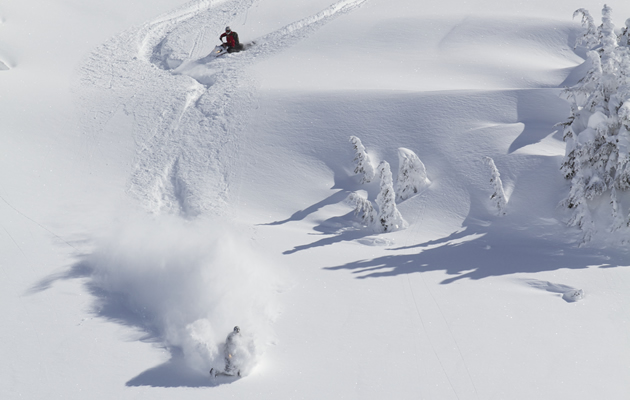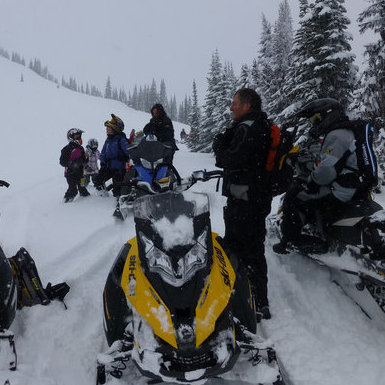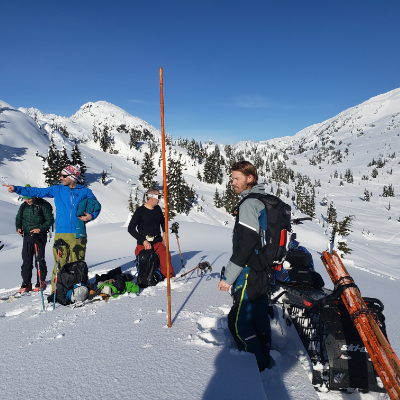Whistler is an anomaly, not just in B.C. or Canada, but in a worldwide sense. Most towns have a history of being built around industry, while Whistler is one of the very few that was built around a mountain—London Mountain, to be exact.
It was in the 1920s that the first visitors started coming to the valley for a stay at Rainbow Lodge with Alex and Myrtle Phillips to partake in the wonderful fishing that the area has to offer. Over the ensuing years, more people came up with their eyes on the surrounding mountains and it was in 1960 that the Garibaldi Lift Company was formed and plans for a new ski resort were put into motion.
Olympic dreaming
The goal was to host the 1968 Winter Olympic Games. This did not happen but, of course, the mountain became one of the top skiing and snowboarding destinations in North America and, of course, the Olympics eventually made their way to the little valley in 2010—firmly stamping Whistler on the world map and in the consciousness of people everywhere.
Long known for its abundant snowfall and accessible terrain with a serious gnar factor in a short matter of time—considering most towns measure their history in hundreds of years—Whistler attracted a very unique population that has a tendency to do things their way as hard as they can.
Underground snowmobilers
A resort-based economy means there is a need for transient employees—and with the incredible snow and terrain, not to mention the world-famous Whistler Bike Park, there is no shortage of people from all over Canada and the world who come to visit for six months or the entire year.
All of these factors, and the fact that it can be a hard place to get ahead, makes for an impression in the eyes of tourists that the local population is nomadic. They often do not see the underground population of locals who have chosen to work hard and make this their home.
It is these locals who have given the area a culture that revolves around pushing personal limits and the boundaries of skiing, snowboarding, mountain biking and sledding. It really can be a never-never land where you find 40-plus-year-old peeps out there hanging with the best of them and charging.
With the media, tourists and the general population swirling around Whistler and the Blackcomb Mountains, it is easy for those not riding the lifts with their skis, snowboards or bikes to go unnoticed—making sledding a rather underground culture of peeps who circulate through the town.
For a world-renowned destination, the Whistler/Pemberton year-round population is actually fairly small, and this leads to everyone knowing everyone and a sledding community that tends to be very tight. Give it a couple of years, make a few friends and you will become part of a circle who are always meeting, shaking hands and throwing high-fives and hugs in parking lots, restaurants, bars, coffee shops, gas stations and on mountains from Squamish through to Bralorne.
Making a transition
Scratch one of the local sledders deep enough and nine times out of 10 you will find a background that has little to do with powersports. Unlike most areas with a thriving sled scene, the Whistler snowmobile culture tends to have roots that tie into the skiing and snowboarding side of the town.
Dan Treadway is a classic example of this progression. Sure, he had snowmobiles as a kid growing up in Ontario, but his passion for riding a sled in the mountains grew out of his desire to ski untouched lines away from the crowds on Whistler/Blackcomb. Following many of his pro buddies with skis strapped to his machine, they would break trail into virgin snow to shred turns. Taking the skis along gradually happened less and less often and he was sledding for the sake of sledding, taking his big mountain skiing background into the sled world.
Unlike most peeps who can trace their sled lineage back through their parents and grandparents, Whistler riders tend to be the first roots in the family tree of their snowmobile history.
Steep and deep
The Coast Mountains are an incredible range of old, blunt mountains rising out of the ocean and drenched in a heavier, damper snowpack than most places. This wet snow, though not blower pow in the sense of the dry, cold interior ranges, falls deep and quickly stabilizes on slopes steeper than in colder climes. This stable snowpack doesn't just mean that steeper slopes can be descended in deeper snow. It also means that big mountain lines can become shreddable when they are in prime pow conditions—steep and deep.
While riders south of the border seem to be more influenced by the crazy, technical tree riding that Chris Burandt has had a heavy hand in promoting and progressing, the sledders in the Whistler area have focused their styles in a very different direction—a direction that is influenced by the Coast Mountains as well as the hard-charging ski and snowboard culture that the Whistler community was built around.
It's all downhill from here, eh
Gravity is a serious force of life. Everything we do is based on this one simple law and it would be impossible to imagine life without it. Gravity is one of the reasons that Whistler exists and can explain a lot about those who live here. They have come to chase gravity's effects while playing on and in the snow.
The Coast Mountains snowpack contains what may just be the perfect moisture content. It is light enough to fly up and bury a rider in the white room but also dense enough to stick and bond—making it safer to ride the big lines that the area is fast becoming known for.
In a sense, the snowpack can defy the pull of gravity so that snowmobilers can enjoy it. While sidehilling in the backcountry and tight trees seems to be all the rage, Whistler riders are still all about pointing their sleds downhill and rooping it up.
Embrace gravity and let it pull you down; whether it’s through the deep snow or from takeoff to landing, it is something to enjoy. Even tree riding here tends to be more about linking up downhill lines, sharing a striking similarity to storm day skiing.
Check out any of the latter half of the Sledneck series of flicks or even the new 509 Volume 7 and you will notice a very different flavour to the riding. Hell, if there is something that the Sledneck riders have in common, it is that the majority of them call Whistler—or Pemberton, which is half an hour to the north—home. The big mountain lines and air time that is popular from the series is coming from guys like Geoff Kyle, Kalle “KJ” Johansson and Chris Brown, who all call the area home and do a pretty sick job of showing off their backyard.
One of the most startling contrasts, though, might just be in the new 509 movie. With most of the filming and riders done and coming from the U.S., it is easy to notice that they all love playing in the trees—tight and difficult riding that comes from guys like Chris Burandt and Bret Rasmussen. Then bam! Chris Brown and KJ show up on screen and tear you a new one with their gravity-assisted downhill, deep pow turns and big air. That is big mountain riding at its finest.
The trickle-down effect
The influence of these guys shredding their downhill lines in the movies isn't the only exposure that Whistler locals get; the sled community is small and most of the regular riders in the area have a circle of friends that includes a few of the pros. This makes for interesting times because not only do you get to witness some serious talent on a sled, but you also get to watch and learn. It is hard for their riding not to rub off on you, at least a bit, and have you out there pushing yourself just a little bit harder than usual.
Khan Young Gee is a classic example of a Whistler local who takes in everything and pushes hard at it all. He is like many Aussies who come to visit, then fall for the town and the culture surrounding it, finding a way to make it home.
Young Gee does the construction gig to pay the bills and in just a few short years of sledding he has become a talented rider who seems to spend as much time in the air as he does on the snow. Of course, part of this revolves around the crew that he shreds with—guys like Tyler Blair, Grant Clarke and Dan Treadway, who seem to think it is only a good day if they log a ridiculous amount of air miles. Young Gee isn't afraid to tee up cliffs, wind lips and cheese wedge boaters—with his favourite riding areas having at least a couple of the above.
This doesn't mean that every sledder in town is riding in this manner. There are still the guys and gals who head out there to climb and roop up some pow. And, of course, there are some folks who do step up to the challenge of trying to scribe lines through gnarly trees.
There is, however, a shift happening that is seeing a lot of young blood coming into the sport from the ski and snowboard background. Parking lots are filling up with people who bought sleds to access the backcountry and they are realizing that the way they look at the mountain, descents, pow turns and air transfers from their boards to the sleds pretty well.
It is a familiarity that is making for some talented riders and, of course, a tighter community of sledders in the valley.






